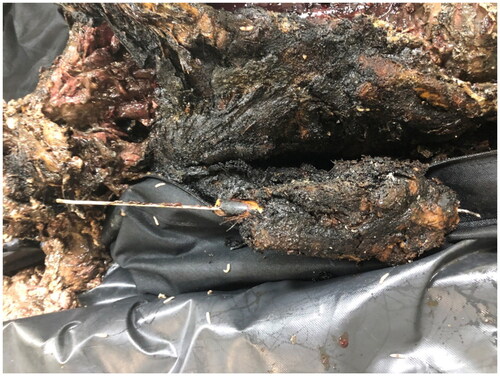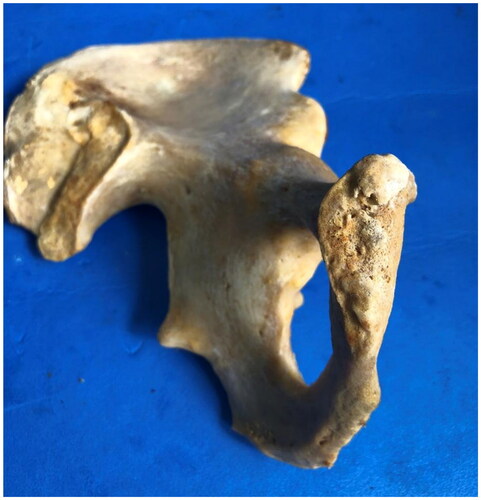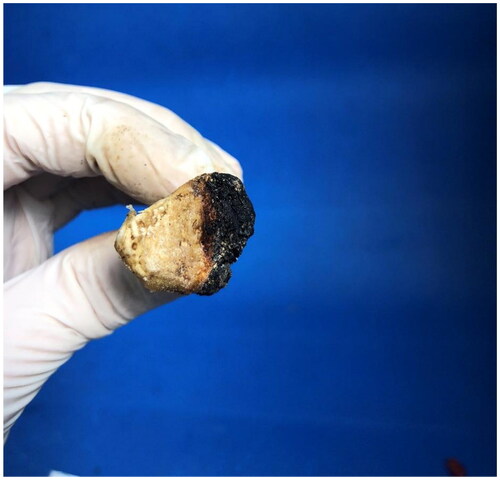Abstract
It is a well-established fact that forensic anthropology has been extremely helpful in identifying thermally altered human remains, especially in recent years. With the improvement of new analytical techniques, the identification success rate has also been increased. With the help of statistical analysis, combined with analytical anthropological methods, the Forensic Anthropology Service of the Afranio Peixoto Medico-Legal Institute succeeded in identifying a charred body, with a margin of error of approximately 1:500 million to be obtained.
Introduction
The Forensic Anthropology Service of the Afrânio Peixoto Medico-Legal Institute (IMLAP) commonly receives charred bodies. Since this is the ultimate destination for bodies awaiting positive identification, experts have focused on improving anthropological identification techniques. This article discusses a case of a burned body received at IMLAP in 2019 for identification purposes.
The material was located, according to the Medico-Legal Service (SML) report from Volta Redonda, at Barra Mansa, Rio de Janeiro. After an initial examination in IML (Medico-Legal Institute), carried out by the Necropsy Routine, he was referred to the Forensic Anthropology Service of IMLAP, with the aim of undergoing a specialized and specific examination, where it was assigned a particular control number for internal organization purposes.
Case summary
The remains were received in a black plastic bag usually used for transporting corpses. Once the body bag was opened, a charred corpse was observed, reduced to a blackish mass measuring about 115 cm in length. The block consists of a skull articulated to the axial skeleton, neck, scapular waist and proximal portions of the upper limbs, trunk, abdomen, pelvis and proximal portions of the lower limbs. The skull, neck and thorax are open, indicating that the corpse has been submitted to necroscopic examination. The organs are still present and the muscles and viscera are partially intact.
A thread (from Kirschner) emerges from the intramedullary portion of the right ulna. Face bones were destroyed, as were the forearms, hands, legs and feet.
Traumas
The bone and dental remains analysed were subjected to intense thermic action in the perimortem time. The skullcap, facial bones, abdomen and distal portions of the four limbs were the most destroyed areas. A continuity solution is observed, addressing the cortical lamina of the inner face of the right iliac, measuring 23 × 11 mm in its largest extensions. The analysis indicates perimortal perforating action. This type of abdominal perforation necessarily injures important structures and organs, making it incompatible with life if the individual does not receive emergency medical assistance.
The presence of the Kirschner wire () in the right ulna reveals that the individual had been submitted to a surgical procedure, constituting an important individualization factor to be confirmed through comparison with antemortem (AM) data.
Sex and age estimation
The right humerus, ulna and radius, the pelvic girdle and clavicles were separated from the carbonized block and sent for maceration and specific exams. Regarding sex estimation, a morphological analysis of the pelvis was performed following the Buikstra and Ubelaker method [Citation1]. Regarding age estimation, the Suchey-Brooks method was applied () [Citation2].
The clavicle shows incomplete formation of its medial epiphysis, indicating age below 30 years () [Citation3]. Aiming to estimate height, the humerus was analysed according to the Mendonça technique [Citation4]. The analysis of ancestry was precluded by the fire.
The postmortem interval (PMI) was estimated based on presence of partially intact muscles and viscera but having already started the evolution of putrefaction. It is estimated that the time elapsed from death to the day of the spoil meeting is less than 2 weeks. We should note that this estimative is only for investigation reference purposes. Also, most of the bones present torsions, irregular longitudinal fractures, deep and thumb nail fractures.
Regarding the cause of death, both the puncture-blunt abdominal action and the thermal action can lead to death. The experts in the Forensic Anthropology Service are limited to the interpretation of the injuries found, their causes and consequences, offering subsidies so that the determination of the cause of death, when possible, is defined by the medical examiner, according to the current legislation. As protocol, a fragment of the radio was collected for future DNA confront.
Identification
The positive identification is the main objective of this case. Therefore, AM data (personal documentation) and postmortem data (biological profile, PMI, investigative information and individualization factors analysis) were confronted.
AM material
An identity card, a Hospital Service Bulletin and the family interview questionnaire were received, containing a name of a specific individual.
PM material and identification procedures
The biological profile analysis was carried out. First, we place the body on a necropsy table in an anatomical-like position. Then, we performed the methodology proposed by Buikstra and Ubelaker on the pelvic bones for sex estimation [Citation1]. Having obtained that information, we proceed to the study of age. The methods applied were: Suckey-Brooks at pubic symphysis and the observation of the degree of closure of the clavicular epiphyses [Citation2]. Regarding height analysis, the method proposed by Mendonça was applied to the humerus [Citation4]. Ancestry analysis was impossible due to severe thermal destruction.
The identification of the individual was performed by comparing the AM and PM data of the Kirschner wire present in the right ulna. It was measured in diameter and length and later compared with the medical record, including the format and others particularities.
A smooth, steel Kirschner wire, measuring 2.5 mm in diameter and more than 300 mm in length, was observed in the right ulna. The surgical orifice performed for implantation of the device has not shown complete bone remodelling. The corpse’s encounter took place in the region where the alleged person lived, inside the family vehicle.
Results
The analysis performed indicated characteristics compatible with an individual belonging to a male, age ranging between 19 and 30 years old and height well above the average observed in Brazilian men (>1.95 m). Also, the body presents a Kirschner wire at the same descriptions of the medical record.
Discussion
The surgical hole performed for implantation of the device does not show completed bone remodelling, indicating a recent procedure.
The finding of the corpse took place in the region where the alleged person lived and within the family vehicle (information obtained from the SAFO family interview questionnaire). Comparing the documentation received with the results of the examinations performed on the cadaver, he obtained full compatibility with regard to the biological profile (sex, age and height) and, especially, in the characteristics related to the surgical intervention to which he was recently submitted.
All the characteristics described above can be observed both in the AM documents, received by this IML, and in the PM documents produced in this “House of Sciences”. The information was statistically treated, allowing a margin of error of approximately 1:500 million to be obtained, providing security for the completion of the procedure (Supplementary Figure S1).
The statistical data consists of biological profile information (sex, age, stature), individualization factors (fractures and surgical procedures), PMI and investigative information (body and residence location, family car). The data obtained were entered into a table and statistically treated, resulting in a cumulative probability of success in achieving positive identification. Margins of error were considered.
The confrontation between the cc (AM) material, composed of the Hospital Care Bulletin and the family interview questionnaire, received from the director of the PRPTC-VR (Regional technical-scientific police post of Volta Redonda) and the PM findings observed in the cadaver points to the total coincidence between the biological profile and the observed anthropological characteristics. Therefore, the information obtained through the construction of the biological profile in association with the examination of individualizing factors and other information allows the experts to establish the positive identification.
We understand that the statistical treatment of the anthropological data provided a solid and reliable basis for the positive identification of the cadaver. Furthermore, statistical data can firmly support the forensic anthropologist in court [Citation5].
Conclusion
The remains belong to only one male individual, which is included inside the 19–30 years old range, with a stature well above the average observed in Brazilian men. It is estimated that the time elapsed from death to the day of the spoil meeting is less than 2 weeks.
The spoil analysed underwent puncture-blunt and thermal action, both have enough energy to lead the individual to death. The information was treated statistically allowing a margin of error of approximately 1:500 million to be obtained, allowing the forensic anthropologists to achieve the positive identification of the cadaver with great reliability.
Authors’ contributions
Marcos Paulo Salles Machado conceived the study and was the responsible one for the coordination and design of this research, and helped to draft the manuscript. Andrei de Souza Santos performed the statistical analysis, time since death study and helped to draft the manuscript. Gabriela Graça provided the anthropology service and carried out the cause of death study. Luciana Lima conceived of the biological profile study. Ricardo Campos Barcellos helped to obtain and analyze antemortem data from family members. All authors contributed to the final text and approved it.
Compliance with ethical standards
This article does not contain any studies with human participants or animals performed by the authors.
Acknowledgments
We would like to thank everyone who contributed to the publication of this work and also those who contributed directly or indirectly in the case reported, in the performed analyses and in the preparation of this manuscript.
Disclosure statement
We, the authors of this article, declare that we have no financial, commercial, political, academic, personal or any other conflict of interest.
References
- Buikstra JE, Ubelaker D. Standards for data collection from human skeletal remains. Research series no. 44. Fayetteville (AK): Arkansas Archeological Survey Research Series No 44; 1994.
- Brooks S, Suchey J. Skeletal age determination based on the os pubis: a comparison of the Acsádi-Nemeskéri and Suchey-Brooks methods. Hum Evol. 1990;5:227–238.
- Mckern T, Stewart T. Skeletal age changes in young American males Analysed from the standpoint of age identification. Natick (MA): Headquarters, Quartermaster Research & Development Command; 1957. (Revisited in 2009).
- de Mendonça MC. Estimation of height from the length of long bones in a Portuguese adult population. Am J Phys Anthropol. 2000;112:39–48.
- Obertová Z, Stewart A, Cattaneo C. Statistics and probability in forensic anthropology. London (UK): Elsevier Inc; 2020.



